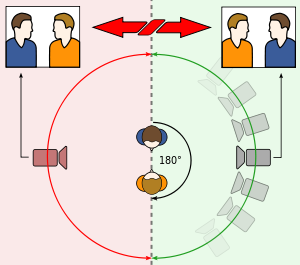Continuity principles:
180 degree rule:
The 180 degree rule states that two characters in the same scene should always have the same left/right relationship. However, if the camera moves to the other side of the imaginary line linking the two characters audiences can become disorientated and confused. This was a guideline we had to follow when shooting our preliminary task and we thought very carefully about not crossing it.
In order to avoid crossing the invisible line we enforced the 180 degree rule by having the characters conversation close to a wall. This helped us not forgot to put it in place as there wasn't really much room to try and film from the other side of the characters, therefore being able to keep the visual well being of the viewers intact.
Match on action:
Match on action is the process of cutting from one shot to another view in order to maintain the motion whilst engaging with the previous shot. The use of this principle makes shot changes more fluid. This was also a principle that we had to enforce in our preliminary task.
Our group managed to execute the use of match on action. For example, in the stills on the right Chione can be seen walking round the corner from one angle and then another. All whilst she is walking in the same manner.
This indicates that we have managed to keep the same pace of action going in a different perspective whilst still ensuring that the shot change is fluid.
Shot reverse shot:
This technique is used in order to show two people looking at each other/talking. Basically, the shot reveals one character looking at another and then it changes to the other character looking at the first character. We had to use this technique in our preliminary task in order to portray a fluent conversation.
As a group we were successful at incorporating the shot reverse shot technique. For example, the first still on the right indicate that Elizabeth is looking at Chione, then we can tell that she definitely is by the second still. The same applies for Chione.
This suggests that we have effectively demonstrated the technique as we have stuck to the main principles and incorporated them into a short conversation.
Specific camera angles:
I believe the use of this Rule of Thirds shot to be effective and quite interesting within our preliminary task. This is because it divides up the shot into points of interest and balances them out in a visually appealing way. For example, Chione is the main point of interest as her position in relation to the shot captures the most attention.
Secondly, I consider the use of our Long Shot to be successful. This is as the shot demonstrates leading lines and gives the location a more narrow feel, this in turn draws more attention to Chione as she is in the center of where the lines follow. The shot also portrays there to be a vanishing point.
Theme of conversation:
We chose our conversation to be about someone falling asleep whilst doing their media work and therefore forgetting/not being able to meet their friend. Therefore, making her friend quite annoyed. The reason we chose this theme was because we wanted to create a realistic dramatic conversation as apposed to delving into something which may be unbelievable or just silly. We also tried to relate the conversation to the topic i.e. Elizabeth falling asleep whilst specifically doing media work.










An excellent extension of your evaluation. Splendid examples of your practice and confident use of media terminology.
ReplyDeleteWell done Adam, a pleasure to read.